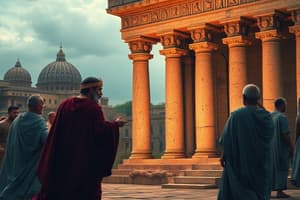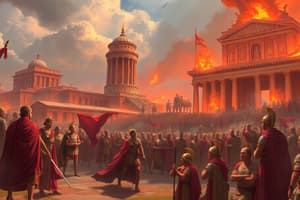Podcast
Questions and Answers
Which factor did NOT contribute to the decline of the Roman Empire?
Which factor did NOT contribute to the decline of the Roman Empire?
- Political corruption
- Economic instability
- Cultural enrichment (correct)
- Military overextension
What significant event marked the end of the Western Roman Empire?
What significant event marked the end of the Western Roman Empire?
- The fall of Constantinople
- Fragmentation into multiple successor states
- Military defeat at the hands of the Persians
- A notable invasion by barbarian tribes (correct)
Which aspect of Roman legacy continues to influence modern systems of governance?
Which aspect of Roman legacy continues to influence modern systems of governance?
- Legal frameworks (correct)
- Mythological storytelling
- Religion
- Architectural styles
Which of the following was a direct consequence of internal strife within the Roman Empire?
Which of the following was a direct consequence of internal strife within the Roman Empire?
Which of these aspects was NOT a result of Roman cultural influence?
Which of these aspects was NOT a result of Roman cultural influence?
Which of the following regions was NOT part of the Roman Empire's territories?
Which of the following regions was NOT part of the Roman Empire's territories?
What was a primary change in governance when Rome transitioned from a Republic to an Empire?
What was a primary change in governance when Rome transitioned from a Republic to an Empire?
What role did the Roman military play in the expansion of the empire?
What role did the Roman military play in the expansion of the empire?
Which of the following was NOT a method used by the Roman Empire to facilitate economic activity?
Which of the following was NOT a method used by the Roman Empire to facilitate economic activity?
In Roman society, who were the patricians?
In Roman society, who were the patricians?
What architectural features were prominent in Roman culture?
What architectural features were prominent in Roman culture?
How did the Roman Empire maintain communication throughout its vast territories?
How did the Roman Empire maintain communication throughout its vast territories?
Which statement is true regarding the different provinces of the Roman Empire?
Which statement is true regarding the different provinces of the Roman Empire?
Flashcards
Roman Empire Decline Factors
Roman Empire Decline Factors
Economic problems, political issues, and military overreach led to the Roman Empire's downfall.
Barbarian Invasions
Barbarian Invasions
Attacks from outside groups weakened the Roman Empire, playing a role in its decline.
Roman Empire Legacy
Roman Empire Legacy
The Roman Empire's influence on Western civilization remains, found in governance, architecture, and culture.
Political Structures
Political Structures
Signup and view all the flashcards
Western Civilization Influence
Western Civilization Influence
Signup and view all the flashcards
Roman Empire Origin
Roman Empire Origin
Signup and view all the flashcards
Roman Republic to Empire
Roman Republic to Empire
Signup and view all the flashcards
Roman Military
Roman Military
Signup and view all the flashcards
Roman Trade Routes
Roman Trade Routes
Signup and view all the flashcards
Roman Social Classes
Roman Social Classes
Signup and view all the flashcards
Roman Infrastructure
Roman Infrastructure
Signup and view all the flashcards
Roman Provinces
Roman Provinces
Signup and view all the flashcards
Roman Taxation
Roman Taxation
Signup and view all the flashcards
Study Notes
Geography and Formation
- The Roman Empire, encompassing a vast territory, originated from the city-state of Rome, situated in the Italian peninsula.
- Its expansion involved conquest and absorption of neighboring territories, eventually controlling much of Europe, North Africa, and the Middle East.
- Key regions included Italy, Gaul (modern-day France), Britain, the Iberian Peninsula, Greece, Egypt, and the Levant.
Political Structure
- Initially governed by a Republic, with elected officials and a Senate.
- Transition to an Empire marked a shift of power to emperors, who wielded significant control over military, political, and economic institutions.
- The empire's administration involved intricate networks of bureaucracy, facilitating taxation, law enforcement, and infrastructure projects.
- Different provinces enjoyed varying levels of autonomy, with some directly ruled by the emperor and others governed under appointed officials.
Military
- The Roman military was a defining feature of the empire, playing a pivotal role in securing and expanding territories.
- A well-organized and disciplined army, equipped with advanced weaponry and battle tactics, proved successful in conquering and maintaining control.
- Legions, large military units, formed the backbone of the army, commanded by experienced generals.
- Effective logistical systems supported the military, ensuring supplies and communication throughout the vast empire.
Economy
- A complex system facilitated trade and economic activity across the empire.
- Extensive road networks, crucial for transportation and communication throughout the empire, were developed.
- The empire controlled significant trade routes, fostering exchange of goods and ideas along these corridors.
- Taxation, a critical source of revenue, supported the infrastructure, military, and bureaucracy.
Society
- Roman society exhibited a distinct social stratification, with varying social classes and roles.
- Patricians, members of the upper class, held significant political and social influence.
- Plebeians, the common people, often struggled for social and political equality with the patricians.
- Slavery was a widespread economic element impacting various aspects of daily life.
Culture
- Roman culture exerted a substantial influence on various aspects of life across the empire.
- Architectural structures, like aqueducts, bathhouses, and amphitheaters, demonstrated sophisticated engineering.
- Literary works and artistic expressions enriched cultural life.
- Legal systems and administrative frameworks provided structured models for future governments.
Decline
- Factors like economic instability, political corruption, and military overextension contributed to the decline of the Roman Empire.
- Invasions from barbarian tribes, combined with internal strife and political crises, weakened the empire.
- The empire fragmented into several successor states, notably the Western and Eastern Roman Empires.
- The eventual fall of the Western Roman Empire marked a significant historical turning point.
Legacy
- The Roman Empire left an enduring impact on Western Civilization.
- Its political structures, legal frameworks, and administrative models continue to influence systems of governance.
- Architectural styles and engineering innovations continue to be studied and admired.
- The influence of Roman culture is pervasive in language, law, and art.
Studying That Suits You
Use AI to generate personalized quizzes and flashcards to suit your learning preferences.




